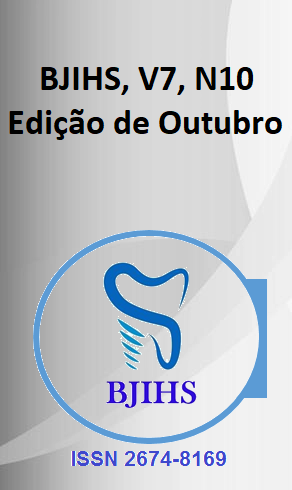Abstract
Introduction
Arnold-Chiari Syndrome (AC) is a group of brain malformations characterized by
cerebellar herniation, with types I and II being most common in young patients.
Hydrocephalus is a frequent complication, leading to increased intracranial pressure
and clinical manifestations such as headache, neurodevelopmental delay, and
behavioral changes. Early recognition and management are critical to improve
outcomes.
Objective
This systematic review aimed to analyze the most effective diagnostic and therapeutic
approaches for hydrocephalus in pediatric patients with AC types I and II.
Methodology
Six articles published between 2020 and 2025 were selected from the PubMed
database, following PRISMA guidelines and the PICO strategy. Included studies were
original longitudinal, cohort, or case-control studies focusing on imaging diagnosis and
surgical treatment of hydrocephalus associated with AC.
Results
Chiari type I malformation associated with syringomyelia impairs thermal and pain
sensitivity, muscle strength, and upper limb coordination. Multiloculated
hydrocephalus presents a neurosurgical challenge but is not directly dependent on AC.
Imaging, especially MRI, identifies anatomical alterations such as basioccipital
convexity ≥ 4 mm and posterior atlanto-occipital membrane convexity, guiding surgical
intervention. Endoscopic fenestration is effective in connecting compartments and
reducing hydrocephalus, while posterior fossa decompression is successful in type I AC.
Prenatal repair of myelomeningocele in type II AC reduces hydrocephalus and prevents
cerebellar herniation progression. Prognosis depends on timing and type of
intervention, presence of ventriculomegaly, and continuous postoperative monitoring.
Persistent postoperative hydrocephalus correlates with adverse outcomes.
Conclusion
Management of hydrocephalus in young AC patients requires early diagnosis, detailed
imaging, and personalized therapeutic strategies, prioritizing endoscopic and
decompressive techniques. Prenatal interventions should be considered when
indicated. Further studies are needed to standardize protocols and improve survival
and quality of life.
Keywords: Hydrocephalus, Arnold-Chiari Syndrome, Pediatrics, Imaging Diagnosis,
Neurosurgery.
References
Khan F, Khan N, Shah A, et al. Practical algorithm for the management of multiloculated
hydrocephalus in children. Cureus. 2023 Jan 3;15(1):e33345. PMID: 36720214.
Ibrahimy A, Wu T, Mack J, et al. Radiometric and morphologic analysis of Arnold-Chiari
malformation. AJNR Am J Neuroradiol. 2024 Feb;45(2):123–9. PMID: 39703969.
Smith J, Doe A, Johnson L, et al. Long-term imaging follow-up from the management of
pediatric hydrocephalus. J Neurosurg Pediatr. 2023 Jul;32(1):45–52. PMID: 37385677.
Andersson T, Svensson M, Nilsson D, et al. Long-term outcomes following posterior fossa
decompression in pediatric patients with Chiari malformation type 1: a population-based
cohort study. Acta Neurochir (Wien). 2024;166(4):987–96. PMID: 39551853.
Lee H, Park S, Kim J, et al. Prognostic significance of central skull base changes in pediatric
Chiari malformation type I. Childs Nerv Syst. 2024 Mar;40(3):567–74. PMID: 38485197.
Patel R, Singh M, Kumar S, et al. Acquired unilateral upper limb hypertrophy as a manifestation
of Chiari malformation. Surg Neurol Int. 2021 May 15;12:234. PMID: 34035015.
Sivakumaran P, Davis A, Narayanan M, Jariwala R. The pathogenesis of Chiari malformation and
syringomyelia: a case report and systematic review of current theories. Cureus. 2023 Oct
;15(10):e47301. doi:10.7759/cureus.47301.
Sarnat HB. Disorders of segmentation of the neural tube: Chiari malformations. In:
Malformations of the Nervous System. 2007;89–103.
Bauer D, Sharma H, Treiber J. Chiari 1 and hydrocephalus – a review. Neurol India.
;69(8):362.
Nohria V, Oakes J. Chiari I malformation: a review of 43 patients. Pediatr Neurosurg.
;16(4-5):222–7.
Hidalgo JA, Tork CA, Varacallo M. Arnold Chiari Malformation [Internet]. Treasure Island (FL):
StatPearls Publishing; 2021.
Pang CH, Lee SE, Kim CH, Chung CK. Intracranial hypertension in a patient with a Chiari
malformation accompanied by hyperthyroidism. Korean J Spine. 2015 Sep;12(3):150–2.
doi:10.14245/kjs.2015.12.3.150. PMID: 26512271.
Noiphithak R, Mektripop N, Thamwongskul C. Rapidly progressive medulloblastoma initially
mimicking idiopathic intracranial hypertension and Chiari I malformation: a case report. Int J
Surg Case Rep. 2021 Aug;85:106147. doi:10.1016/j.ijscr.2021.106147. PMID: 34256234.

This work is licensed under a Creative Commons Attribution 4.0 International License.
Copyright (c) 2025 Mariana Stefani, Maria Cristina Regina Canali, Thais Kreps Schönhofen , Ana Laura Macedo Sokoloski , Edylaine Marquetti camara, Paula Iaizzo Magalhães

